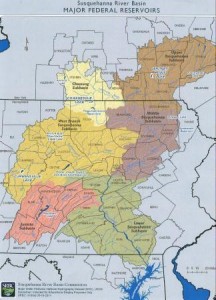
CLEARFIELD – A meeting on Monday night regarding proposed drawdown changes at Curwensville Lake by the Susuqehanna River Basin Commission brought a crowd of concerned citizens with questions.
The purpose of the meeting was two-fold: to inform the public of the proposed plan and to gather input that might factor into the proposed plan or make it altogether moot.
The SRBC started with some history of the lake and their involvement. In 1994, the SRBC signed an agreement with the Army Corps. of Engineers to purchase water supply at Curwensville Lake. The SRBC uses the stored water to help supplement consumptive uses during low water or drought periods. Consumptive uses can include agricultre, nuclear power plants, Marcellus usage … essentially any use of water in the river basin that does not return water.
Representatives from the SRBC stated that the current protocols for initiating a drawdown is from the 1970s, and is outdated. Since the time that formula came out, the SRBC reps stated that new scientific data is available to better determine when a drawdown should occur. So the SRBC is looking at alternative trigger values and locations as part of its study.
The SRBC is taking a number of things into consideration, including the lake’s multiple uses (water storage, flood control, recreation and wildlife habitat). SRBC representatives also acknowledged the current efforts by the Curwensville Lake Authority to put together a new master site plan. The representatives indicated they would be willing to work with the CLA if the impacts of the proposed drawdowns are significant enough and frequent. They stated that in the past, they had helped with some facility upgrades in the recreation area.
When the public Q&A segment hit, a lot of the questions revolved around who controls the SRBC, how they’re funded and what they govern. One of the keys they tried to reiterate during the question session was that the SRBC’s mandate is water quantity, not water quality. They were also drilled on Marcellus Shale water usage and how it relates to their study. The SRBC reps said the basis for the study and the study itself were under way long before the Marcellus Shale play in the area.
County Commissioner John Sobel brought up the Barnes and Tucker disaster that resulted in millions of gallons of water being diverted from the Susquehanna River and into the Ohio River. The water is slated to be rerouted back to the Susquehanna River later this year. Sobel asked if the SRBC had taken that water into consideration. The representatives stated that they had, but also stressed that the Barnes and Tucker water was earmarked for agricultural use down river.
Other concerns voiced by the public and elected officials is how this might impact their communities
Another item the SRBC reps touched on was the timeline they’re working under They stated that if the Army Corps. accepts their study, the next phases would include, design, implimentation and a water control plan.
The SRBC reps said they will return in the fall with a more fleshed out plan and data.
For more information on the SRBC, check out their Web site.